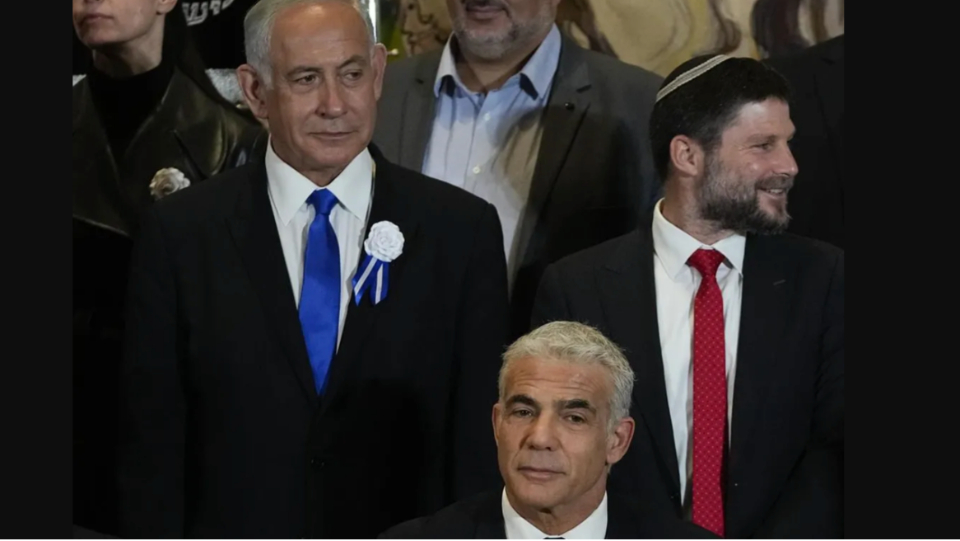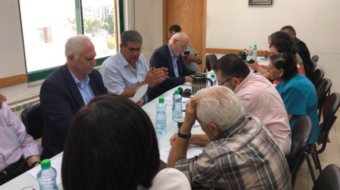
TEL AVIV—The troubling results of the recent elections to the Knesset (the Israeli Parliament), held on November 1, generated interest around the world for their possible repercussions on the situation in the Middle East and the danger they pose to the cause of Palestinian freedom.
Benjamin Netanyahu, the staunch right-winger who was Prime Minister from 2009 to 2021, will return to office after a year and a half in opposition. His major coalition partner, for the first time, will be the party of the extreme right, having gained enough votes to become the third biggest faction in the Knesset. The state of the Israeli left is ever more dire, with two parties, Meretz and Balad, failing for the first time to pass the 3.25% minimum threshold of votes to be represented in the Knesset, thus losing all of their seats.
As Netanyahu forms his government and gives high-ranking positions to his partners—including, for the first time in Israel’s history, ministers who openly subscribe to the extreme racist Kahanist ideology—we analyze the elections results and the prospects for the coming years for the Israeli left and for those forces within Israeli society that oppose the Occupation and support Palestinian independence and a just peace.
Rise of the extreme right
When in the 1980s, the ultra-reactionary Rabbi Meir Kahane ran for the Knesset, he was considered a fringe phenomenon. Having won a single seat in the 1984 elections, his four-year tenure was marked by racist statements, most notably his insistence on the forced transfer of Arab-Palestinians away from the territories controlled by Israel. As a legislator he attempted to introduce racial segregation laws, including, for example, having different beaches for Jews and non-Jews, and proscribing romantic and sexual relationships between Jews and non-Jews, punishable by prison terms. So vile was his racism that he was ostracized even by the right-wing members of Knesset, including the ruling Likud Party, who used to leave the Knesset chamber whenever he was giving speeches. In 1988 he was disqualified to stand for reelection by the Central Elections Committee, on the grounds of his party platform’s incitement for racism.
Having become a hotbed of violent settler activity, Kahane’s party and its successor organization were designated a terrorist organization by Israel and the U.S., and declared illegal. Kahanism survived on the outskirts of Israeli politics, as a marginalized tendency of a few fanatic zealots, never numbering more than a few hundred, not wielding actual political power and being covered by the media as a mere curiosity.
But as the Israeli political establishment plunged into crisis—with five consecutive elections during the past four years—Kahanism made a comeback into the political arena. Itamar Ben-Gvir, who joined Kahane’s movement as a teenager, led his party, called “Jewish Power,” in two consecutive elections, in 2019 and 2020, winning no seats but proving to be a headache for the more mainstream right-wing parties. His breakthrough came when he negotiated a deal with the “Religious Zionism” party, which succeeded the “Jewish Home” party as the main party representing the interests of the settlers in the West Bank, and won himself a single Knesset seat in last year’s election, being a candidate on the “Religious Zionism” slate.
As a highly media-savvy member of Knesset, known for his provocative appearances, he soon became a favorite for news programs. One newspaper headline exclaimed that “The broadcast media is addicted to Itamar Ben-Gvir,” citing a statistic that in the last week of March, against a backdrop of violent attacks towards Israeli citizens, Ben-Gvir was the second-most covered politician in radio and television, surpassed only by Prime Minister Naftali Bennett.
During the recent elections, Ben-Gvir capitalized on his growing personal popularity and renegotiated his electoral pact with the “Religious Zionism” party, to increase representation for his “Jewish Power” party. It was a definite success, with the slate doubling its percentage of votes, from winning 7 seats in the 2021 elections (out of the total 120 Knesset seats), to winning 14 seats in 2022, among them six members of “Jewish Power.”
Netanyahu the right-populist
Contrary to the extreme right, which ran a campaign focusing on racist incitement toward the Palestinian citizens of Israel, the recent election campaign of Netanyahu’s Likud Party was more nuanced. It proved successful in its effort to get out the vote among traditional Likud supporters, whose abstention from voting in 2021 resulted in Netanyahu being driven to the opposition. With Likud’s having mismanaged the economic crisis that followed the COVID pandemic, with rising unemployment and tens of thousands of small businesses going bankrupt, many Likud voters punished the government last year by staying home on election day, opening the way for an anti-Netanyahu coalition rise to power.
In his effort to energize his voter base, Netanyahu’s campaign emphasized social spending (such as free education through age three) and promised to tackle the problem of cost of living, especially rising housing prices. These burning problems were worsened by the neoliberal policies of the incumbent government, which implemented unpopular austerity measures: raising the age of retirement for women workers, privatizing the post office, raising the prices of public transportation, opposing an increase in the minimum wage, and canceling jobless benefits for those made unemployed by the COVID pandemic.
Another aspect of Netanyahu’s election campaign was racist delegitimization of the parties which represent the Arab-Palestinian citizens of Israel, especially the United Arab List (known by its Hebrew acronym “Raam”) headed by Mansour Abbas. This party, a conservative Islamic movement, which up until recently was permanently in opposition, dropped a political bombshell last year when it agreed to enter the anti-Netanyahu coalition, giving Prime Minister Naftali Bennett the needed votes to muster a narrow 61 majority in the 120-seat Knesset. Keen on driving a wedge between the Arab parties and the Israeli centrist parties, Netanyahu’s campaign bombarded Israeli voters with messages aimed to present the Arab politicians as illegitimate coalition partners, and even claimed that the rising cost of living is because of budgets allocated to Arab towns and villages, as part of the agreement between the United Arab List and the ruling coalition.
Thus the Netanyahu formula was a mixture of social rhetoric with racist hate-mongering, which bumped the Likud from 30 seats in last year’s election to 32 seats, remaining the biggest faction in the Knesset.
Netanyahu’s two traditional coalition partners, United Torah Judaism (representing mostly Ashkenazi ultra-Orthodox Jews) and Shas (representing Sephardic ultra-Orthodox Jews), also focused their election campaigns on the dire economic crisis badly affecting their Haredi voter base, which is predominantly poor. Shas ran a campaign under the slogan “Israel’s only social party,” promising to finance food vouchers for the poor, while United Torah Judaism used the slogan “If your life is precious to you” (which in Hebrew is a play on words, also meaning “If your cost of living is high”). This focus on bread-and-butter issues helped increase the representation of Shas from 9 to 11 seats. United Torah Judaism grew slightly (from 5.63% to 5.88%) and remained at 7 seats.
The bourgeois bloc
While the incoming Netanyahu right-wing coalition will be a relatively homogenous one, the outgoing government was a big tent comprised of diverse parties: Some are right-wing (such as “Israel is Our Home” party, headed by hawkish Avigdor Liberman, Minister of Finance), others position themselves in the center (like the “Yesh Atid” party, whose Chairperson, Yair Lapid, replaced Bennett as Prime Minister less than four months before the elections), and two of them—Meretz and the Labor Party—are self-described parties of the Left. They were joined also by the National Unity Party, itself a coalition between a right-wing party (formed by renegade Likud members who turned against Netanyahu, but not against many of Netanyahu’s policies) and the centrist party of former Army Chief of Staff Benny Gantz.
All of these parties were united by two things only: their hatred of Netanyahu, and the fact that the social basis on which these parties rested was upper-middle and upper classes.
An analysis conducted by the news site “Davar” operated by the Histadrut trade-union federation, is very telling. Using the Socio-Economic Index published by the Central Bureau of Statistics, they compared election results by ballot precincts with the characterization and classification of geographical units by the socio-economic level of the population. This enabled them to find correlation between the socio-economic clusters of the population (1 being the poorest and 10 being the richest) and voting patterns according to parties. The data, presented below, boldly highlight the socio-economic cluster in which each party was the strongest:
We learn that among the poorest strata in Israeli society (socio-economic clusters 1-3) voters overwhelmingly supported the Arab parties (Raam, Hadash-Taal and Balad) and the ultra-Orthodox parties (Shas and United Torah Judaism). This reflects the high level of poverty and social exclusion among the Arab-Palestinian minority in Israel, which suffers from national discrimination, and also that of the Haredim (ultra-Orthodox Jews). Among the middle strata (socio-economic clusters 4-7) the Likud Party dominates, being the preferred choice for lower-middle classes in Israel. And among socio-economic clusters 8-10, the party of Yesh Atid, headed by outgoing Prime Minister Yair Lapid, takes the lead, followed by the other center to center-left parties that participated in the outgoing government coalition (Meretz, Labor Party and National Unity Party).
This reflects the deep failure of the two parties that are self-described Social-Democratic – Labor and Meretz – to orient towards working people and to win votes outside of their current base, which is among educated, urban, upper classes. For Meretz this failure meant disappearance from the Knesset, and possibly also from the political scene in general, having plunged deep into debt as a result of the failed election campaign. For Labor, this means receiving its worst result ever, dropping to 4 seats (3.69% of the votes, being the smallest faction in the Knesset). To appreciate the crisis this party is facing, one can recall that 30 years ago it dominated more than a third of the seats in the Knesset by itself, and that merely seven years ago, the Labor Party was leading the second biggest faction in the Knesset, after Likud, with its slate receiving 18.7% of the vote.
Arab politics in crisis
The formation of the Joint List in 2015, an electoral coalition that for the first time united all of the political currents among the Arab-Palestinian minority in Israel, was seen at the time as an opportunity to increase the influence and to better living conditions of the Palestinian citizens inside the pre-1967 borders of Israel, who suffer from systematic discrimination in all walks of life, although nominally being equal citizens of Israel and eligible to vote in the Knesset (unlike their fellow Palestinians who live under military rule in the territories occupied since the 1967 war).
A shaky coalition, the Joint List eventually broke down into its component parties: Raam (the United Arab List) opting to join the government, even entertaining the idea of joining a Likud-led government placing its focus on civic equality for Palestinians living inside Israel, and blurring its support for the Palestinian national cause; Balad (the National Democratic Assembly) refusing any cooperation with non-Arab parties, pledging opposition to any future coalition, even that of the parties opposiing Netanyahu’s right-wing bloc; and the joint slate of Hadash (the Democratic Front for Peace and Equality, the electoral front of the Communist Party) that ran together with Taal (the Arab Movement for Change, led by the popular veteran politician Ahmad Tibi).
Raam and Balad both agreed that there is no inherent difference between a government led by the right and one that is led by the center-left. But for Raam this meant that its participation is not excluded in any of these governments, while for Balad this meant it refused not only to partake in any such government, but also to come to terms with it on a supply-and-demand basis. Hadash-Taal’s position was different, in the sense that it was willing to lend outside support for the center-left, in order to block Netanyahu’s return to power with his extremist coalition partners.
Raam’s position was popular, especially among the Arab-Bedouin population in the southern Negev desert, who are traditionally responsive to the conservative and Islamic leadership this party provides, and after more than a year in government, they increased their Knesset representation from 4 to 5 seats. Hadash-Taal was hitting the panic button and alerting its supporters, in the last few days before the elections, that it is dangerously close to the 3.25% threshold and it might not make it to the next Knesset. It eventually kept its five seats, but the feeling among party cadres was that they were dealt an electoral blow.
Balad was daring, opting to run by itself, without a coalition partner, something it hadn’t done in close to a decade. Although polls predicted it would receive around 1% of the vote, it amazed pundits when it was able to energize young Palestinian voters and reach 2.91% of the vote. On election night, news coverage of party headquarters showed celebrations, an oddity for a party that lost its seats in the Knesset, after being represented there for more than 25 years, but understandable considering it garnered far more public support than expected.
What’s next?
The next Netanyahu government will be a dangerous one, first of all, to Palestinians in the Occupied Territories. “Jewish Power” and “Religious Zionism” will take key government positions and plan to oversee both an expansion in settlement construction in the West Bank and East Jerusalem, as well as to increase home demolitions in Palestinian villages there. Palestinian citizens of Israel are also expected to be targeted, with Itamar Ben-Gvir taking the newly designated title of “Minister of National Security,” responsible for the police force and promising to form a “National Guard” in order to “bring back law and order” to the Galilee and the Negev, i.e., to those parts of Israel with a high Palestinian population.
In Israel’s LGBT community and in the feminist movement many were upset over statements made by Netanyahu’s coalition partners, especially Avi Maoz, a fundamentalist homophobe elected on the “Religious Zionism” slate, who will be responsible for a new “Jewish Identity Authority.” Community organizations fear a rollback in civil liberties won over the years.
While many turn to hopelessness or apathy, a different course is needed. In response to the new extremist government, we should not throw our hands up in despair, but organize and fight. The new government, basing itself on electoral support from working people and unemployed, won over by promises for social spending and by hate-mongering towards Palestinians, will nonetheless not be able to solve any major social or economic problem. The Kahanists promise to bring “law and order,” but their policies will actually increase violence on the streets and lead to a diminishing sense of security. Likud and Religious Zionism are dominated by conservative politicians bent on privatizing, cutting public services and lowering taxes for the rich. The economic crisis, epitomized by the housing crisis, stagnant wages and rising cost of living, creates contradictions between the government and the people, and these can serve as opportunities by socialists in Israel, acting collectively and strategically, to take advantage of these dynamics in order to build a people’s opposition.
While Meretz disappeared from the map, and both Labor and Hadash are licking their wounds, one movement that emerged empowered following the election was Standing Together (“Omdim b’Yachad” in Hebrew, “Naqef Ma’an” in Arabic). A grassroots political movement of Jewish and Arab-Palestinians citizens of Israel, grounded in socialist values, we did not contest the Knesset elections, but our movement was able to posit itself, following their results, as an alternative to the existing crisis-ridden political structures of the left. With a membership surge of almost 400 new dues-paying members, Standing Together, which currently boasts of more than 3500 members, Jews and Arabs, across Israel, is the biggest socialist political movement in the country.
As the government will try to deepen oppression and dispossession in the Occupied Palestinian Territories, as well as to spark violence toward the Palestinian community in Israel, our movement is best experienced in mobilizing Jewish and Palestinian citizens of Israel in anti-war and anti-Occupation protests, as we did by the thousands during last year’s May events. Not being content simply with responding to government actions, this movement will also take the initiative into its own hands by campaigning on issues such as solving the housing crisis or raising the minimum wage, pressuring the government and straining the ties between elected politicians and the demands and needs of their voter base.
Our aim is an ambitious one: to (re)build a People’s Left in Israel, one that is inclusive and unites people from various communities, across differences, around shared interests—Jews and Palestinians, religious and secular, people from big cities in the center of the country as well as people who reside in small towns in the geographical peripheries. We plan not only to energize the existing left in Israel, but also to broaden the scope of whom we organize and with whom we talk to in order to persuade and win over. This is a strategy of building power in order to win, and it something badly needed for progressives and socialists in this country.
The original publication in Europe Solidaire Sans Frontières can be found here.












Comments